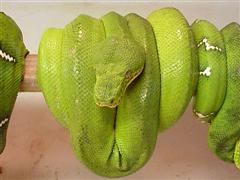Boa - Emerald tree
Scientific Name: Corallus caninus
Mon, 28th April, 2025 - 12:29 pm GMT
Sponsor Ads:

Alternative Name
Scientific Name: Corallus caninusBasic Info
Like the name implies, the Emerald Tree Boa has a brilliant light green color. They are also characterized by the presence of white markings. At maturity, the Emerald Tree Boa reaches a maximum size of six to eight feet. As with other tree boas these are slender snakes. Their maxillary teeth are shed periodically. The heat pits around their lips are prominent.
Health
The Emerald Tree Boa is considered relatively difficult to care for two reasons. The first is that they are a very aggressive snake, and the second is that they have high humidity requirements. The temperature of their cage should be about 85 degrees Fahrenheit during the day. Humidity should be high; between 85% and 100%, which can be accomplished by misting the habitat several times a day, or by using an automated misting system. Emerald Tree Boas are accustomed to 12 hours a day of light, due to living near the equator. In captivity, they should be exposed to the same. This snake is most active at night. Breeding The cycling of temperature, humidity, and lighting is a very important factor in getting the Emerald Tree Boa to reproduce. In other words, an environment closest to their natural environment is best. Temperatures should cycle between 70 and 80 degrees Fahrenheit, which should correspond to a change in humidity from 85 to 100%, this change in temperature and humidity should be consistent with the 12 hour lighting cycle. Gravid females should be kept at higher temperatures around 90 degrees Fahrenheit. Females should be introduced into the male's habitat for best results. Emerald Tree Boas are live bearers, and will take roughly six to seven months to gestate. Roughly 7 to 14 baby snakes will normally be produced for each breeding. Babies can be red, yellow, or green but are most often red. As they mature they will change to green after roughly nine months. Juveniles should be fed pinky mice, if the babies do not want to eat pinkes try fuzzies.Habitat
Found in the Amazon Rainforest of South AmericaBehavior
The Emerald Tree Boa's beautiful green coloration is striking. Their beautiful appearance is making the Emerald Tree Boa a highly desirable part of many snake enthusiast's collections. The Emerald Tree Boa is strictly arboreal. It prefers to spend all of its time in the trees. If an Emerald Tree Boa is found on the ground, it is usually because there is something wrong with it. Emerald Tree Boas like to coil over tree branches and they rest their heads roughly in the middle of the coils, as is the case with many tree snakes. The Emerald Tree Boa may not be well suited for beginners because of its highly aggressive temperament and its high humidity requirements. They are so aggressive that some enthusiasts call them "Legless Werewolves". In some cases they can be handled, though this requires a lot of work and is an exception rather than a rule. As with all tree boas they have longer teeth to aid in capturing birds in the wild. As a result these can inflict a painful bite. As a rule when keeping these snakes one should stick to "look but don't touch". With the arboreal nature of the Emerald Tree Boa, its habitat should be large, but should lean towards the tall side. It should contain plenty of plant life and branches for the snake to live in. These are generally not the most active snakes, sometimes they will go for weeks and only move and inch or so in position. The average lifespan of the Emerald Tree Boa is 15 to 20 years.Origin
South AmericaHistory
The Emerald Tree Boa, or "Corallus caninus", is found in the Amazon Rainforest of South America. They mostly inhabit Brazil, but can be found in Colombia, Peru, Ecuador and Bolivia. They are found in altitudes between sea level and 1000 feet.Common Foods
N/ASponsor Ads:
"The stronger men will be in front, the jaded ones will fall behind, and on this plan only one-tenth of your army will reach its destination." -- Sun Tzu, The Art of War
Boa - Emerald tree
Coded by: BGID® | ALL RIGHTS RESERVED Copyright © 2000-2025
Disclaimer | Privacy | Report Errors / Contact | Credits








 Why haven't we as a collective earth met with aliens yet?
Why haven't we as a collective earth met with aliens yet?  The Best Text Adventure You Will Ever Play! The official site:
The Best Text Adventure You Will Ever Play! The official site:  Homosexual behavior stems from the mind or genetics?
Homosexual behavior stems from the mind or genetics?  World EcoSystem - Biodiversity Changes - Who is on board and who isn
World EcoSystem - Biodiversity Changes - Who is on board and who isn  Mouthwash - Mouthrinse - Mouth Sores - Healing Infections - Gingivitis
Mouthwash - Mouthrinse - Mouth Sores - Healing Infections - Gingivitis  Treatment for Depression
Treatment for Depression  Ultra radical and violent Islamist group that even rivals Al Qaeda
Ultra radical and violent Islamist group that even rivals Al Qaeda  An idea to have teachers who want to carry guns to school undergo some level of police training will be left up to local school districts and police departments.
An idea to have teachers who want to carry guns to school undergo some level of police training will be left up to local school districts and police departments.